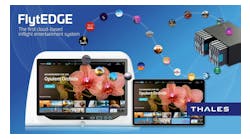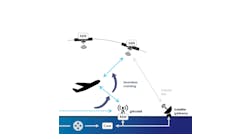Regardless of Operation, Communication is Key
Operation and maintenance configurations as well as system components requirements for communications systems will vary depending on whether it is used for pushback or deicing operations. However, officials at David Clark Company say they have the equipment necessary to keep ground crews connected during any operation.
“Pushback systems usually consist of a crew lead (typically the tug driver) and a pair of wing walkers,” explains Bob Daigle, systems product manager at David Clark. “In this set up, all crew members typically wear the H9935 headset.
“The tug driver’s headset is connected to the Model U9910-BSW wireless belt station, which provides VOX-enabled, hands-free intercom between the tug and wing walkers, and a momentary PTT which is pressed to transmit to the flight deck,” he continues. “Wing walkers would use the Model U9913-BSW, which is similar in every way to the tug unit except that their PTT does not transmit to the flight deck, but only over-rides the VOX button for emergency transmissions.”
With this set-up, all ground crew will hear communications to-and-from the flight deck, and their VOX circuit, in conjunction with the headset noise-cancelling microphone, effectively eliminate ambient noise from the system, keeping communications crystal clear.
All ground crew units are linked to a Model U9920-GPB Pushback Gateway, which acts as a relay for all wireless communications between the users on the ground as well as the flight deck. The U9920-GPB bridges the ground comms and flight deck by connecting to the aircraft interphone system with a Gateway Interface Cord, thereby achieving a single pilot-to-ground communication system.
“A simple volume control on the Gateway regulates the volume of transmissions from the flight deck to the ground crew,” Daigle says. “In most cases, maintenance crews will utilize the U9920-GPB Gateway as a central link for their ground communications as well, with or without an active connection to the flight deck.”
When it comes to deicing operation configurations and system components, the company’s Series 9900 Wireless Deicing systems are available to accommodate hands-free VOX communication for driver and bucket crew positions, as well as configurations allowing monitoring and PTT via mobile radio for more comprehensive communication airport-wide.
“For radio transmit capability, the U9922-G38 Wireless Gateway in installed in the deicing vehicle, powered directly from the vehicle’s battery (11-30 VDC) and connected to the vehicle’s mobile radio,” Daigle says. “The deicing vehicle driver is typically equipped with an H9990 single ear headset, allowing the ability to hear more ambient sound from the airfield to enhance situational awareness.
“The bucket operator is typically equipped with an H9935 headset,” he adds. “The driver and bucket operator headsets are each connected to model U9910-BSW wireless belt stations, providing full-duplex, hands-free VOX communication with one another and radio transmit through the belt station PTT switch.”
In an intercom only configuration, where no radio is used, the headsets would remain the same as above, but the driver is equipped instead with the Model U9911-BSC Controller Belt Station. This unit acts as the system gateway and is linked to the U9910-BSW belt station worn by the bucket operator.




